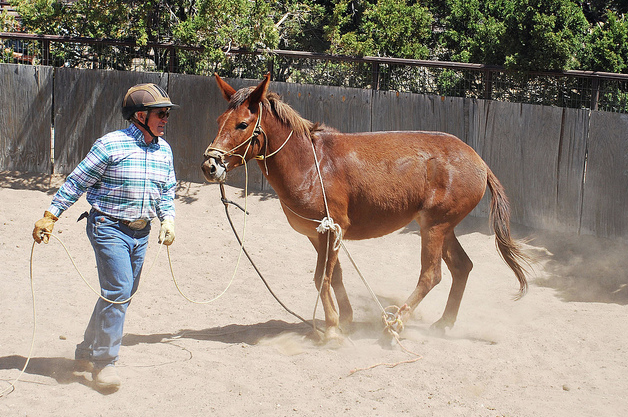
Troxel Athlete, Steve Edwards has been training mules and donkeys for over 30 years. He and his wife, Susan, operate the Queen Valley Mule Ranch in Queen Valley, AZ, where they offer clinics on understanding and training mules, donkeys, and their owners. Steve also sells his own custom line of mule and donkey-friendly saddles and tack which he has used personally at the ranch since 1981. Here, Steve disspells the common stereotype of the "stubborn" mule and explains why they're a great choice for your next trail ride.
ATTENTION TRAIL RIDERS! If you have ever considered trail riding a mule because you like their physical abilities but you're afraid they will be “stubborn” – maybe I can help! After all, I've never seen a stubborn mule.
Mules are half horse (natural defense for horses is to RUN) and half donkey (more likely to turn, face and fight). So, when mules find something concerning along a trail, they like to have a look and evaluate the situation. Whether it's wildlife, an obstacle like a bridge or water, or any other novelty along the way, mules are likely to stop and check it out. They can spook just like a horse. But, they're less likely to be as easily alarmed. Many riders report that their mules hardly spook compared with horses.

Often times when a mule stops like this to check something out, people think they're being “stubborn”. Instead, they might be figuring out how they can best do what needs to be done. Mules have a great sense of self-preservation and will do what they feel is safe. They'll look to their rider to be a leader, but together, mule and rider can team up and tackle most any obstacle. It does no good to kick a mule to go forward before he/she is comfortable that you will lead him/her through it. So, instead:
- Keep your mule facing the obstacle
- Focus on the point where you would like to go
- Use your legs, seat, voice and hands to ask your mule to move
It's true that a mule is often more level-headed and less “emotional” than some horses – especially when the rider is a strong leader. Forging a relationship with your mule, using tack that fits him/her and serves the purpose, and training your mule to respond to your cues are all part of a solid foundation for taking a mule on the trail. Be a leader and be a rider!
One of my students told me a story about a ride she had with some friends. All of her fellow riders were on horses while she was riding her mule. They encountered a water crossing that was fairly deep. Since my student and her mule were in the lead, the mule stopped at the edge of the creek. One of her trail buddies scolded her saying, “You can’t let that mule just stop like that!"

My student responded explaining, “she is just checking it out”. But, her trail buddy pushed on spurring her horse into the water. Her horse then stumbled and dumped the rider in the water. Both were swimming and the horse that had followed them in also took an unexpected "swim".
While they were gathering themselves, my student and her mule entered the water. Their focal point was on the other side of the creek. My student and her mule traveled slowly and she allowed the mule to pick her way a bit while keeping focus on the desired destination. They reached the other side dry and happy and better for the partnership. She never thinks of her mule as “stubborn” either.
